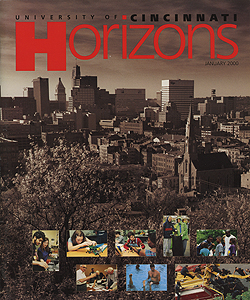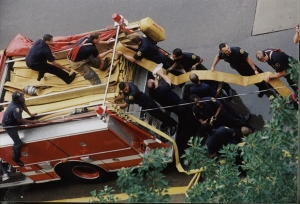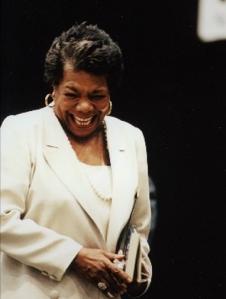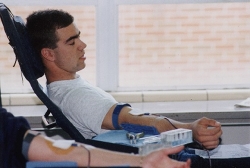At UC, it's just the neighborly thing to do
by Deborah Rieselman
 January 2000
January 2000
UC's Hidden Impact
 Past Issues
Past IssuesBrowse our archive of UC Magazine past issues.

Photo/Lisa Ventre
Blindly navigating a smoke-filled room, the two firefighters had to rely on their sense of touch. Although both were certainly anxious and remained cautious over getting disoriented, losing precious time and staying alert for the unexpected, they knew what they were doing. That confidence was evident moments later, when one of them reached through the third-floor window with a child cradled in his arms.
Friends and neighbors would proclaim the duo heroes. The media would talk of a near tragedy. And administrators at the University of Cincinnati would quietly smile, knowing that UC had a small role in the outcome even though few people realized it.
During a previous summer, UC had helped boost the firemen's confidence by providing a practice field for navigating smoke-filled hallways -- on the sixth floor of an unoccupied UC dorm. One August, eight Cincinnati Fire Department trucks and 40 firefighters had swarmed the dorm for training exercises.
The university's role in the subsequent drama may have been small, but it reflects the type of relationship UC forges with the community each day. As Cincinnati's fourth-largest employer, the university is a significant part of the neighborhood and strives to set an example of civic responsibility.
"We may not toot our own horns, but a place as large and complex as this has to be a good citizen to the larger community," says Mitchel Livingston, UC's vice president of student affairs and human resources. "You just don't take up this much space and influence without having a civic responsibility."
Signs of that responsibility vary tremendously, particularly when dealing with 13,450 employees and 34,000 students at 19 different colleges and divisions. Some projects are narrowly focused, like the College of Education's instruction for various Sunday school superintendents. Other projects reach the entire Tristate, like the radio station WGUC, for which UC holds the FCC broadcast license.
And some are absolutely vital, like the university's Hoxworth Blood Center, which distributes more than 200,000 blood components to 25 hospitals in 14 counties each year. Still other connections have changed the way the entire world lives, such as the invention of Benadryl, the first antihistamine, developed at UC by alumnus researcher George Rieveschl, A&S '37, MS (A&S) '39, PhD (A&S) '40, Hon. Doctorate '56.
Whether the university and its people are concerned with saving lives or simply providing a free ball field for Little Leaguers, President Joseph Steger responds as if such consideration is to be expected. "Universities are funny places," he says. "Our goal is to be taken advantage of.
"We're one of the few places that invites you here to take advantage of everything we have. That's what students do, and the community should, too."
Although that viewpoint may be foreign to many, others have gladly accepted the offer. In particular, a few ball teams were thrilled to do so over the summer.
In June and July of 1999, 72 community baseball games were played on UC's Johnny Bench Field -- many of them free of charge. Instead of the field sitting vacant over the summer, hundreds of feet were running and sliding into base. Afterward, a fair amount of money was needed to groom the turf back into shape for the Bearcats' two dozen season games.
Fewer students on campus in the summer creates an ideal situation for hosting many events, such as sports camps, academic summer schools and leadership programs. When students return in the fall, the number of community activities does not decline, but shifts to evenings and weekends.
Fall through spring, the College-Conservatory of Music, for example, conducts a Saturday preparatory program for children aged 18 months to 18 years, then maintains a steady flow of visitors after hours attending an average 1,000 performances, ranging from ballets and musical theater productions to concerts and operas. It's the largest single source of performing arts presentations in the entire state.

When Maya Angelou lectured on campus, the public was invited. Photo/Lisa Ventre
Elsewhere on campus, the public is attracted to numerous guest lectures and poetry readings. In recent years, UC speakers have included Maya Angelou, Colin Powell, Bill Moyers, Edward Albee and experts from fields such as real estate and archaeology.
Perhaps the program drawing the largest regular crowd is the Institute for Learning in Retirement, which is celebrating its 10th anniversary. Nearly 1,000 older adults attend 103 classes throughout the school year.
But UC does more than invite and entice the public to its campuses. Students and educators eagerly respond to the needs of others wherever they occur.
At the Avondale Branch Library last school year, faculty taught free adult-education courses on African American culture. Every fall, the Greek system spends a Saturday cleaning up trash in the neighborhood. During rush week, sorority sisters and "rushees" create boxes of school supplies for underprivileged children. After the holidays, alumni and students team up to do minor repairs at surrounding urban schools during the Crosstown Helpout.
The list of projects is endless. And although each service is quite valuable on its own, some of the student charity work involves a caliber of professional services that one can only properly refer to as pro bono, not free. Law is a perfect example.
Through the College of Law's Office of Public Service and Professional Development, students can integrate classroom theory with actual legal practice in a variety of ways: serving as an extern with a service organization, teaching high school students about legal issues through the "Street Law" program, answering questions from landlords and tenants through the Tenant Information Project student hotline and participating in the Public Interest Law Group. The group is a student-sponsored organization that provides summer fellowships in nonpaying public-interest positions, sponsors a student chapter of Volunteer Lawyers for the Poor and prepares and serves dinner at a homeless shelter with the Cincinnati Bar Association.
On the other side of campus, pro bono work continues at the Medical Center (see "Nursing a forgotten population") and the College of Business Administration.
At the latter, the genuine importance of students assisting elderly and low-income people with income-tax returns often falls under the shadow of other business-college endeavors. Specifically, its Center for Productivity Improvement has assisted with scheduling of American League umpires, routing systems for snow and ice control, forecasting lost sales due to a hurricane and selecting a plant site for Owens-Corning.
Yet even those achievements pale in comparison with a 1993 project in which the center helped save Procter & Gamble $200 million a year. The center's collaboration with three P&G managers resulted in computerized tools used to restructure P&G's North American product supply chain. That was no small task, considering the system consisted of hundreds of suppliers, more than 50 products, more than 60 plants, 10 distribution centers and more than 1,000 customer zones.
Although big numbers from big businesses sound impressive, such alliances are not the college's sole aim. Its Goering Center for Family and Private Business has helped 2,000 very different customers, as the name implies, and in 1997, the college discounted five management-training spaces to United Way executives, making the cost much more attainable for the nonprofit corporation.

Hoxworth Blood Center gets 10 percent of its blood supply through high school donors (such as this student at Felicity High School). Photo/David Baxter
Despite the university's glowing track record, the average person may still think of UC only in terms of classrooms and occasionally sports, concedes vice president Livingston. "We may not be known for our good-neighbor initiatives," he admits. "There are a lot of them, but we do things quietly without trying to get visibility."
President Steger agrees, "We're not doing it as community service," he says. "We're doing it because that's what we're designed for. We're a university.
"We do so much that it is just mind-boggling," he adds. "We're really ubiquitous: Football players visit people in hospitals. Local lawyers take advantage of our law library. Anyone in town could come to our main library and get access to 27 million volumes through the OhioLINK database. You can't do that anywhere else in town.
"A lot of our research gives people the best health-care quality in the world. And our docs don't get reimbursed from the Hamilton County tax levy. That means they are giving away about $13 million a year in free medical care."
Although UC doesn't talk about these numbers very often, its economic impact upon the community is sizable. Based upon fiscal year 1996, the Inter-University Council of Ohio put together a lengthy "Economic Impact Statement" involving Ohio's 14 universities. The University of Cincinnati led the pack with an economic impact on the state of $2.04 billion.
The Columbus Dispatch actually praised UC over its hometown Ohio State University. "The champion university for economic impact," the paper reported, "might be the University of Cincinnati, which pumped 12 times as much into the economy as the state invested in the school." Calculations were based upon the estimated spending of campus employees, students and visitors.
Helping balance the picture was the university's excellent history of attracting income. "For each $1 the state of Ohio invested in the University of Cincinnati, the university generated an additional $2.42 for its operating expenses from other sources," the report stated. "The university captured more than $64 million in public- and private-sector research grants and contracts. With these dollars, the university is generating new economic opportunities for Ohio by creating new ideas, innovating technologies and products."
But that was '96. By the '99 fiscal year, UC had raised external support to $92.6 million, setting an institutional record.
"Although we continue to serve as a public institution, we budget as a private institution," says President Steger. "The past decade has demonstrated the wisdom of this approach."
Even though having a financial impact of $2.04 billion is impressive, UC's financial contribution to the area multiplies when one considers the services it contributes. The university virtually offers free consulting by the fact that faculty and administrators serve on hundreds of civic and corporate boards. Many of them could have staggering long-term influences.
The value of having UC personnel sit on boards is not something anyone cares to place a sum on; however, it took only simple arithmetic for the Medical Center to calculate its charitable contribution to heath care: $81 million in 1997, including uncompensated services provided by faculty physicians, all completely outside of the indigent care provided by the Hamilton County Hospital Levy.

UC sorority's annual clean up of the neighborhood. Photo/courtesy of Panhellenic Council
No matter how one calculates the dollars, the UC Medical Center's larger contribution to society exceeds simple figures. Its research is truly priceless.
The development of Benadryl is one example. Not long after that, UC researcher Albert Sabin, HonDoc '74, developed the first oral polio vaccine, which came into general use in 1961. In '98, university researchers designed a $1.5 million Interventional Magnetic Resonance Imaging suite that enables doctors to use MRI technology while operating on the brain. Traditionally, a patient had to be transported to another building for an MRI, then wait a day or two for results, which might have indicated the need for additional surgery.
Two current studies are identifying a simple blood test to help predict which heart patients are at higher risk of dying in their sleep and determining the most effective and least costly strategy for treating sore throats.
Other studies have had no greater impact upon life than to simply add some frivolity. For instance, while working at UC, former professor Paul Herget designed the shape of Pringles potato chips for Procter & Gamble, which wanted a chip that would stack in a can.
The university's focus on research led the Carnegie Commission to name it a "Research I University," an honor granted to only 88 colleges or universities out of 5,000. The benefits of the designation were recently pointed out in the local Metropolitan Growth Alliance's Gallis Report: "University research is fundamental to the continued evolution of the regional economy in the information age. Significant research money is attracted to the area's universities, especially at the University of Cincinnati in the area of biotech and other disciplines."
"There is an overall philosophy that service is part of the university's mission," says Livingston. "There are a lot of different ways to do that -- the quality of academic programs, faculty, research. All of that is critical, but the other question is: Is there a heart and soul to the place?
"People think better of the institution when they see representatives being concerned about community matters. Our image is shaped by those who get out into the community and provide service to others. A better relationship happens. We give something to the larger community, but we also get something out of it."
Such an administrator may have keen insight into the big picture, but the personal vision of a student is also refreshing. Venus Campbell, president of the Panhellenic Council and a Tri-Delt, sums it up nicely: "I read once that if the whole world were a village of only 100 people, only one would get to attend college.
"That makes me feel very blessed. We sometimes take things for granted, but we are all very blessed to have the lives we lead and to go to school here. I feel it's our duty to give something back to the community."
Links:
UC College-Conservatory of Music
Institute for Learning in Retirement (now Lifelong Learning Institute)
Center for Productivity Improvement
Goering Center for Family and Private Business